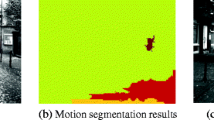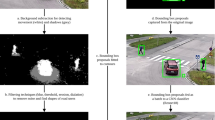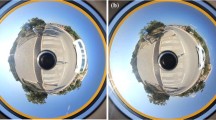Abstract
In this paper we apply the analytic feature framework, which was originally proposed for the large scale identification of segmented objects, for object detection in complex traffic scenes. We describe the necessary adaptations and show the competitiveness of the framework on different real-world data sets. Similar to the current state-of-the-art, the evaluation reveals a strong degradation of performance with increasing occlusion of the objects. We shortly discuss possible steps to tackle this problem and numerically analyze typical occlusion cases for a car detection task. Motivated by the fact that most cars are occluded by other cars, we present first promising results for a framework that uses separate classifiers for unoccluded and occluded cars and takes their mutual response characteristic into account. This training procedure can be applied to many other trainable detection approaches.
Access this chapter
Tax calculation will be finalised at checkout
Purchases are for personal use only
Preview
Unable to display preview. Download preview PDF.
Similar content being viewed by others
References
Ciresan, D.C., Meier, U., Gambardella, L.M., Schmidhuber, J.: Deep, Big, Simple Neural Nets for Handwritten Digit Recognition. Neural Computation 22(12), 3207–3220 (2010)
Dalal, N., Triggs, B.: Histograms of Oriented Gradients for Human Detection. In: CVPR, pp. 886–893 (2005)
Dollar, P., Wojek, C., Schiele, B., Perona, P.: Pedestrian Detection: A Benchmark. In: CVPR, pp. 304–311 (2009)
Gao, T., Packer, B., Koller, D.: A Segmentation-aware Object Detection Model with Occlusion Handling. In: CVPR, pp. 1361–1368 (2011)
Hasler, S., Wersing, H., Kirstein, S., Körner, E.: Large-scale real-time object identification based on analytic features. In: Alippi, C., Polycarpou, M., Panayiotou, C., Ellinas, G. (eds.) ICANN 2009, Part II. LNCS, vol. 5769, pp. 663–672. Springer, Heidelberg (2009)
Leibe, B., Schiele, B.: Interleaved Object Categorization and Segmentation. In: BMVC, pp. 759–768 (2003)
Lowe, D.G.: Distinctive Image Features from Scale-invariant Keypoints. IJCV 60(2), 91–110 (2004)
Schulz, H., Behnke, S.: Learning Object-Class Segmentation with Convolutional Neural Networks. In: ESANN, pp. 151–156 (2012)
Torralba, A., Murphy, K.P., Freeman, W.T.: Contextual Models for Object Detection Using Boosted Random Fields. In: ICIP, pp. 653–656 (2011)
Winn, J., Shotton, J.D.J.: The Layout Consistent Random Field for Recognizing and Segmenting Partially Occluded Objects. In: CVPR, pp. 37–44 (2006)
Yi-Hsin, L., Tz-Huan, H., Tsai, A., Wen-Kai, L., Jui-Yang, T., Yung-Yu, C.: Pedestrian Detection in Images by Integrating Heterogeneous Detectors. In: ICS, pp. 252–257 (2010)
Author information
Authors and Affiliations
Editor information
Editors and Affiliations
Rights and permissions
Copyright information
© 2013 Springer-Verlag Berlin Heidelberg
About this paper
Cite this paper
Struwe, M., Hasler, S., Bauer-Wersing, U. (2013). Using the Analytic Feature Framework for the Detection of Occluded Objects. In: Mladenov, V., Koprinkova-Hristova, P., Palm, G., Villa, A.E.P., Appollini, B., Kasabov, N. (eds) Artificial Neural Networks and Machine Learning – ICANN 2013. ICANN 2013. Lecture Notes in Computer Science, vol 8131. Springer, Berlin, Heidelberg. https://doi.org/10.1007/978-3-642-40728-4_75
Download citation
DOI: https://doi.org/10.1007/978-3-642-40728-4_75
Publisher Name: Springer, Berlin, Heidelberg
Print ISBN: 978-3-642-40727-7
Online ISBN: 978-3-642-40728-4
eBook Packages: Computer ScienceComputer Science (R0)




